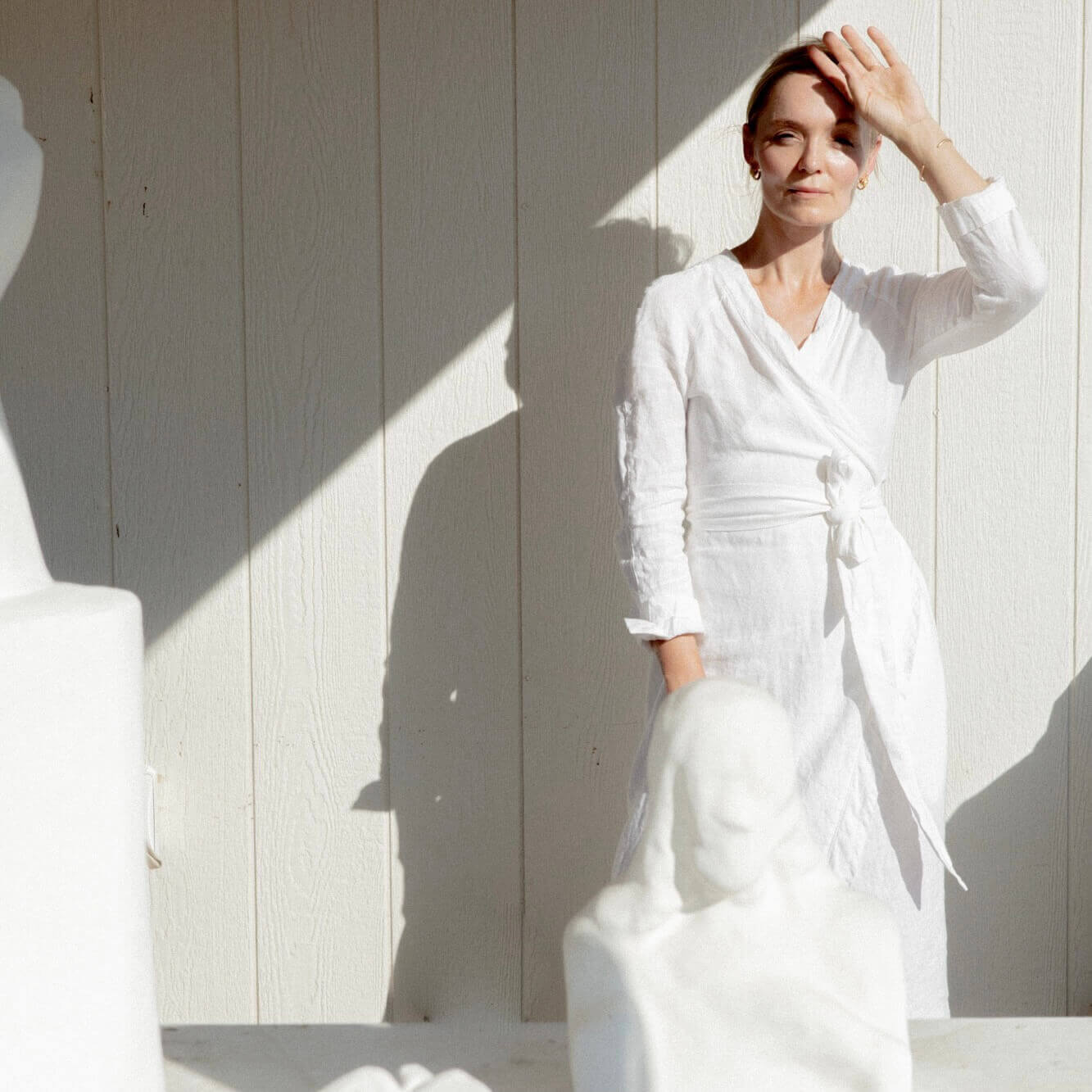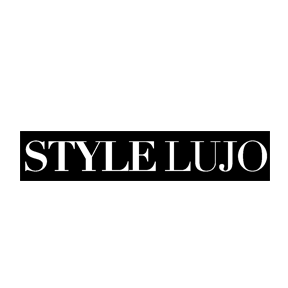Written by Mariepet Mangosing
Patricia Vernhes, founder of Mojave Skin Shield, relishes in one simple philosophy: self-inquiry starts with the way we feel. From connecting with the planet through conscious, thoughtful garment design and construction to the organic skincare applied to protect us from the elements, Vernhes hoped to create a line for the multi-faceted person; one who cares deeply about what is happening all around them. Her non-traditional roots as an artist in Poland and the United Kingdom, and subsequent move to Joshua Tree more than a decade ago leads her boundless curiosity on how to shift our perspective toward self-reliance in an individualistic sense, to a closer look on how we can share these tools with the community at large.
You started your career as a pop artist before creating sculptures and installations, looking to other cultural elements for inspiration. What other events brought you to this place of skincare and fashion design?
I had a pretty unusual childhood, growing up in Poland under a communist regime whilst my parents were subversive artists whose work became instrumental to establishing a young democracy. To us, film and literature were like food; we needed references in order to understand our place in the global reality, especially after the fall of the Berlin Wall. It wasn’t until I moved to the United Kingdom in the mid-90’s to attend college that I realized just how intertwined music, fashion, film, and art really are. These discoveries shaped me as a young artist, but they also gave foundation to an unquenchable thirst for understanding the multi-level meaning of freedom: self - family- community - society - civilization.
Each of these levels creates opportunities for self enquiry. After studying music, humanities, art, and culture I took another trajectory; I devoted 10 years to immerse myself in the studies of Yoga & Ayurveda. This blend only deepened my yearnings and once I discovered the Mojave Desert, there was no going back.
The desert gifted me space to begin a new dialogue; to rearrange priorities, recalibrate and repurpose myself. It taught me how to listen to the quiet voice. My skincare formulas really came in meditation at first, as did the treatments. It also showed me that abundance is closely linked to simplicity. Finally, it brought me the best people, love, and family.
I became self-reliant regarding design; I made clothes instead of buying them, I made skincare. I offered treatments and hosted gatherings. Above all creative outputs, there was the service to people; infinite sharing. It felt so good; I realized I wanted to share this with the whole world. And so began the journey that brings us to where we are now. It still never ceases to amaze me.
What about the desert inspires you, and influences your shift towards fashion and beauty design?
The desert is like a minimalist heaven; on the surface it looks dry and arid, yet underneath the first impressions it's teaming with life. At first it feels quiet, only to reveal a richness of sounds, from coyotes to owls to echos, to whatever you place in front of you. Over-styling here is simply impossible, but utility can dictate the most solid style. It's neither feminine or masculine; it is human, in all its ‘heightened-awareness’ kind of glory.
Sustainability and thoughtfulness seems to be the main coda in your work; the silent exchanges between humans and the places that we inhabit. Given the discussion about how the world is quickly changing towards a more virtual space, what about bringing it back to the elements is striking to you?
The idea that we cannot escape them; our bodies need peace, comfort and protection, but our senses need inspiration. How we blend in and what we communicate is a sum of all things: how we walk, how we talk, what we wear, what we smell like. How we take care of ourselves can come from many places, such as vanity or love. Longevity, sustainability, thoughtfulness; it is our own Medicine, and by this I mean the Medicine of our ancestors - Collective Knowledge.
What led you to the manifesto that essentially says, “if you take care of yourself, you can take care of others”?
I always feel like every moment matters; perspective can be a great muse. Before I moved to the desert I often thought that I was missing that regal, mighty human concept; the true regal soul thing, not ego. The idea of being regal because of how you act, how you show up, and how you make others feel. At MDSS it permeates everything, such as how we make our skincare, choose our ingredients, artisans, partners, and leaders; what we give and offer when you commune here. It's not an easy dance, but everyone has to figure it out. If human ethics really mattered to all, we would be in a different place today as a planet.
What kind of advice do you find the most empowering?
Nurture. Share. Preserve. Follow Your Intuition. Stay Radiant.
How do your philosophies for life translate to your philosophies regarding skincare?
I create products that do not contain fillers; they are all about the active ingredients, including the botanicals, clays, and oils. We create the formula around the active ingredients, so to speak; to nurture their healing potential and preserve their goodness so they can be shared with the world. Hence our ethos: Nurture + Share + Preserve.
We also deeply believe that skincare is basically food for the skin, and that skin, being our largest organ, metabolizes whatever it is given. Skincare should be not only clean but also organic, just like food. We carefully source our raw ingredients to make sure they are made in an Earth-friendly way. Plants have so much power; skincare can be potent , organic and smart all at the same time.
How do you approach design when it comes to your products, both aesthetically and chemically?
There are so many aspects of creating thoughtful goods for the modern human. It’s embracing our culture and heritage, it's a commitment to our artisans; it is creating a food chain. To me, the people who make our products are like family. I am really proud to support their families and their skills through intentional, fairly priced collaboration. Personally, it's a creative output that I absolutely love.
I draw inspiration from film and history; from stitch types to boot shapes, weaving methods, and vintage coat patterns. My mom had this amazing vintage weekend bag which we turned into our Weekender bag. We just try to improve and upgrade it all, having fun while making the pieces as durable and timeless as possible.
Our philosophy is driven by the idea of the person, and the essential purpose behind each piece. For example, the wrap dress is titled the Day Round Ritual Wrap Dress because you can literally wear it to tend to your garden, then wash your hands, roll down your sleeves and go to dinner. The Totem Bucket Handbag is our homage to the medicine bag. It’s meant to carry the things that matter; uncluttered, easy-to-find objects protected by a simple, yet timeless style vessel. The Chiara dress was inspired by a dear friend of mine who wore a vintage linen dress to one of our meetings. She exudes creativity and self reliance; I actually found this dress shape on a post-war photograph from the streets of Paris. I wear mine almost daily, because that embodies who I am when I am at home in the desert. I roll up my sleeves and tackle all projects the best I can; I am a mother, homemaker, an artist and facilitator in my wellbeing space. My clothes support me in my purpose, and I meet so many women who say they need this philosophy to wear their own daily clothes. I am truly honored to dress my friends and clients.
As with skincare, we are very careful and thoughtful about how we source our fabrics. Our linen comes from a collection of custom archival prints from a family-owned flax field and factory in Northern Europe. Our cashmere and alpaca is farmed and woven in Nepal by women who have been weaving using their traditional methods for generations.
I believe this philosophy slows down consumerism and creates lasting goods that can perhaps be handed down to the next generation. We just need to look after what we have, inside and out.


















